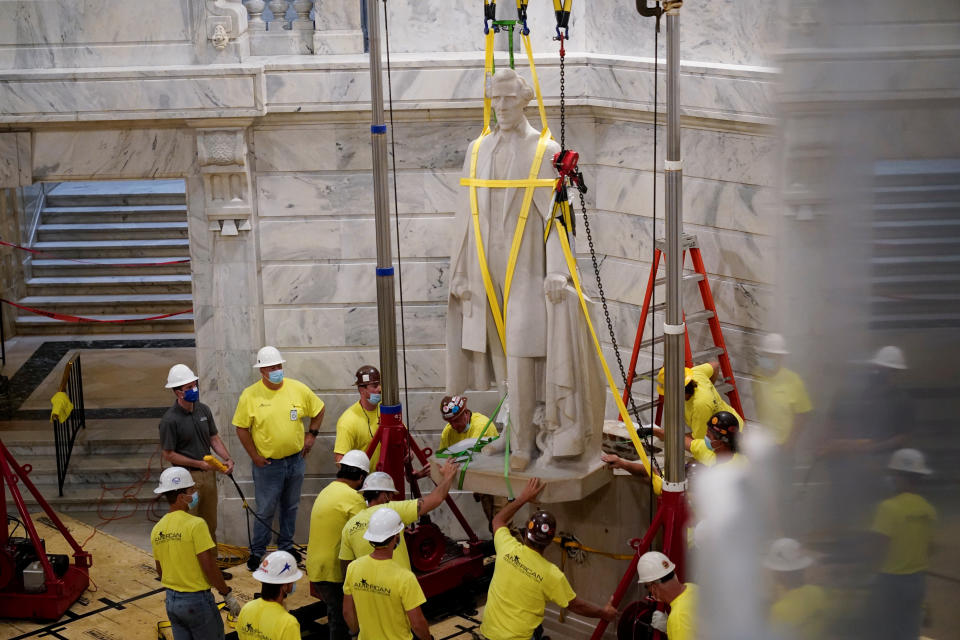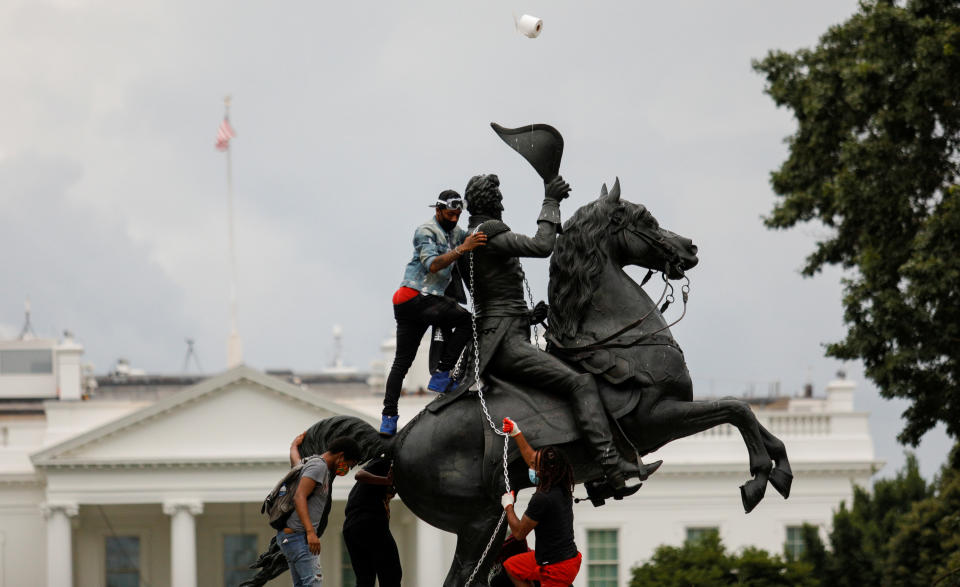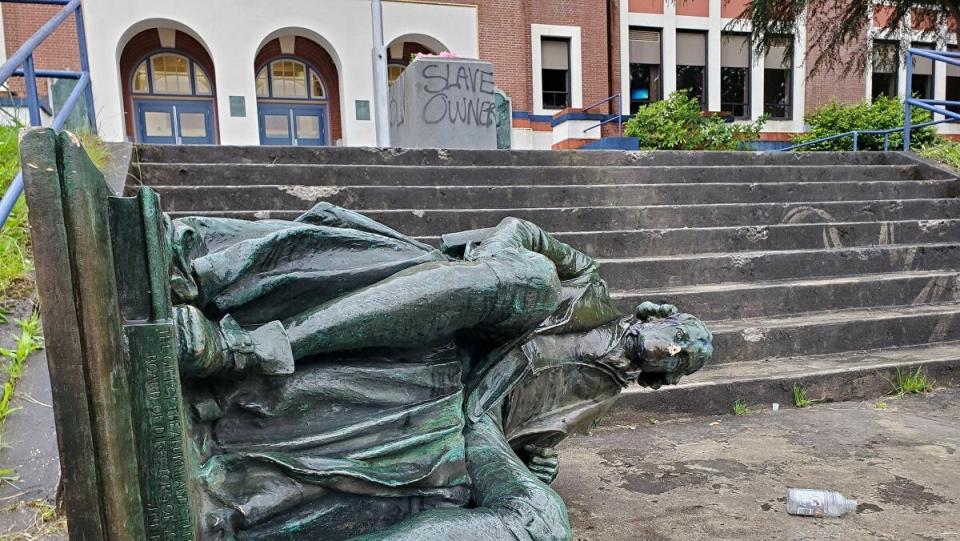Statues fall as Americans rethink their history, and heroes
The war over the proper way to remember the nation’s troubled past heated up this week as police dispersed a crowd attempting to pull down a statue of Andrew Jackson — Donald Trump’s favorite predecessor — near the White House. But memorials to other former presidents, including George Washington and Thomas Jefferson, fell to the crowds that have been gathering nightly in many cities since the death of George Floyd in Minneapolis galvanized public support for the Black Lives Matter movement.
While many Americans believe the nation should not continue to glorify the memory of the Confederacy and the institution of slavery, others, like President Trump, have countered that keeping memorials and honorary names in place honors the “Great American Heritage.”
The number of statues that have been removed — some placed into storage by government officials or local institutions and others yanked to the ground by protesters — illustrates how broad the reevaluation of historical reputations has been.
Historians, of course, are always reassessing the past in light of new research and evolving social and political values. The men (as they all are) whose statues have been toppled aren’t being written out of the history books; the protests are directed at the idea that they deserve a place of honor in America’s civic life.
Here are six examples that illustrate both straightforward cases (an ardent supporter of slavery who made war on the United States) and more complex ones (the Union general who defeated the South but once briefly was a slave owner) for the removal of statues meant to honor the figures they depict.
Jefferson Davis, 1808-1889
Kentucky’s Historic Properties Advisory Commission voted on June 12 to remove a statue of Jefferson Davis from the state Capitol in Frankfort, where it had stood since 1936. Davis was not just a slave owner and unrepentant apologist for slavery as “a moral, a social and a political blessing,” but literally a traitor to the United States, the president of the Confederacy for the duration of the Civil War. In the aftermath, counties, schools, parks, museums, mountains, hospitals and highways were named after him, as well as former Attorney General Jeff Sessions. In recent years, statues of Davis have been taken down across the country, and that has only sped up in the wake of Floyd’s killing and the nationwide protests that have followed. On June 10, protesters pulled down a Davis statue on Monument Avenue in Richmond, Va., the former capital of the Confederacy.

Ulysses S. Grant, 1822-1885
President Ulysses S. Grant — the man who led the Union Army to victory over the Confederacy, thereby helping to bring about an end to slavery — seems an unlikely target for protests inspired by Black Lives Matter. But a statue of Grant was ripped from its pedestal in San Francisco’s Golden Gate Park by protesters on Juneteenth, the holiday marking the end of slavery in America. Grant, some of the protesters noted, had owned a slave the year before the Civil War. And as president he presided over some of the bloodiest battles of the Indian Wars. Yet Grant freed his own slave before the Civil War began, insisted on equal treatment for African-American and white prisoners of war by Confederate forces and sought to destroy the Ku Klux Klan in the years after the North’s victory. As president, he helped ratify the 15th Amendment to the Constitution, which gave African-Americans the right to vote.
Nearby statue of Ulysses S. Grant is also toppled. He was a slave owner too, before the Civil War. That’s three for three this night. pic.twitter.com/Lyw6bXeOTO
— Joe Rivano Barros (@jrivanob) June 20, 2020
Theodore Roosevelt, 1858-1919
The American Museum of Natural History in New York City announced Sunday that it would remove an outdoor statue of Theodore Roosevelt, the 26th president of the United States, who helped the museum assemble its collection of artifacts. The objections to the monument had less to do with Roosevelt himself than with the statue, by American sculptor James Earle Fraser, which depicts Roosevelt on horseback alongside two walking figures of African-American and Native American men. The iconography had been the subject of numerous complaints from patrons who considered it a homage to colonialism.
“Over the last few weeks, our museum community has been profoundly moved by the ever-widening movement for racial justice that has emerged after the killing of George Floyd,” the museum’s president, Ellen V. Futter, said in an interview with the New York Times. “We have watched as the attention of the world and the country has increasingly turned to statues as powerful and hurtful symbols of systemic racism.”
New York Mayor Bill de Blasio said the city supported the museum’s decision to remove the “problematic” statue, and Roosevelt’s own great-grandson, a trustee at the museum, said he also agreed. But Trump signaled his displeasure with the planned move.
Ridiculous, don’t do it! https://t.co/VYez8p9AJh
— Donald J. Trump (@realDonaldTrump) June 22, 2020
Andrew Jackson, 1767-1845
Andrew Jackson, the seventh president, brought 14 slaves from his Tennessee plantation with him to the White House in 1829. By the time of his death he owned 150 African-Americans. As president he oversaw the forcible relocation of Native Americans from ancestral land east of the Mississippi, an act of genocide that is remembered as the Trail of Tears. The brutal eviction cleared land for rich white settlers to start cotton plantations run with the slave labor of Black people. Trump is said to admire Jackson and hung a portrait of him in the Oval Office.
On Monday night, protesters gathered near the White House in Lafayette Square, where they attempted to pull down a statue of Jackson. In response, Trump threatened them with 10 years in jail.

Thomas Jefferson, 1743-1826
The primary author of the Declaration of Independence, Thomas Jefferson penned the words that would change the course of history: “We hold these truths to be self-evident, that all men are created equal.” But when he laid down that principle, Jefferson himself was a slave owner, and over his lifetime he would buy more than 600 slaves. It is now widely accepted that a woman who was enslaved in his household, Sally Hemings, was also his mistress and the mother of at least six of his unacknowledged children. He was by no means alone. Twelve of the first 18 presidents owned slaves. At the same time, however, Jefferson often spoke out against the institution of slavery and thought it represented the single greatest threat to the survival of the country, and he favored a plan to emancipate slaves gradually over time.
Last week, protesters in Portland, Ore., cited Jefferson’s slave-owning past to justify the toppling of a statue of the third American president that stood in front of Jefferson High School.
At his rally in Tulsa, Okla., on Saturday night, Trump railed against the protesters, saying that “the left-wing anarchists tore down a statue of Thomas Jefferson.”

George Washington, 1732-1799
Like Jefferson, George Washington was a slave owner who often expressed reservations about the institution. He inherited his first slave at the age of 11, upon the death of his father in 1743. At the time of his death in 1799, Washington owned 123 slaves at his Mount Vernon plantation in Virginia. Famously, his own dentures comprised teeth pulled from the mouths of men he held in bondage. Months before Washington died, the nation’s first president wrote in his will that his slaves should be freed after the passing of his wife, Martha, who died in 1802. But the slaves belonging to Washington were instead transferred to his wife’s family.
The same Portland protesters who toppled the statue of Jefferson also downed one of Washington, spray-painting the words “Genocidal Colonist” on it. A second statue of Washington was defaced in Baltimore last week, the words “Destroy Racists” painted on its pedestal.
Cover thumbnail composite: Bryan Woolston/Reuters, Timothy A. Clary/AFP via Getty Images, Joe Rivano Barros/Twitter
_____
Read more from Yahoo News:



